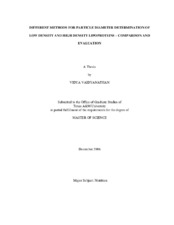| dc.description.abstract | Predominance of small dense Low Density Lipoprotein (LDL) is associated with
a two to threefold increase in risk for Coronary Heart Disease (CVD). Small, dense HDL
(High Density Lipoprotein) particles protect small dense LDL from oxidative stress.
Technological advancements have introduced an array of techniques for measuring
diameters of LDL and HDL as well as estimating overall particle heterogeneity.
However, there is lack of comparative studies between these techniques, and, hence, no
conclusive evidence to establish the merits of one method relative to others. The primary
purpose of this study was to compare Nondenaturing Gradient Gel Electrophoresis
(NDGGE) and Dynamic Laser Light Scattering (DLLS) methods in determining LDL
and HDL particle diameter. Our comparison entailed: 1) Evaluating the two methods in
terms of their reproducibility 2) Correlating the two methods(in future studies method
selection would be driven by time and cost considerations if the two methods correlate),
and 3) Evaluating the two methods in terms of their ability to identify bi-modal samples.
A secondary purpose of this research was to investigate the effect of refrigerated plasma
storage on particle diameter. Reproducibility was measured as Coefficient of Variance (CV). Within and between runs, CV for LDL and HDL for NDGGE were <6% and
<15%, respectively and for DLLS, CV within runs were <3% and <5.5%, respectively.
No correlation was observed between LDL diameter from the two methods. NDGGE
showed two bands for 157 HDL samples of which only 24 samples showed bimodal
peaks in DLLS. In order to study the effect of storage, three sample sets of LDL and two
sample sets of HDL were used. NDGGE showed a significant difference between mean
diameter of fresh and stored LDL and HDL sample for all sets, whereas DLLS showed a
significant difference in only one LDL sample set and none for HDL sample sets. We
conclude that DLLS may be a better method for measuring LDL diameter because
NDGGE overestimated LDL diameter. However, NDGGE was able to resolve
subpopulation better in an HDL sample than DLLS. Thus, NDGGE may be a better
choice for measuring HDL diameter than DLLS. | en |


